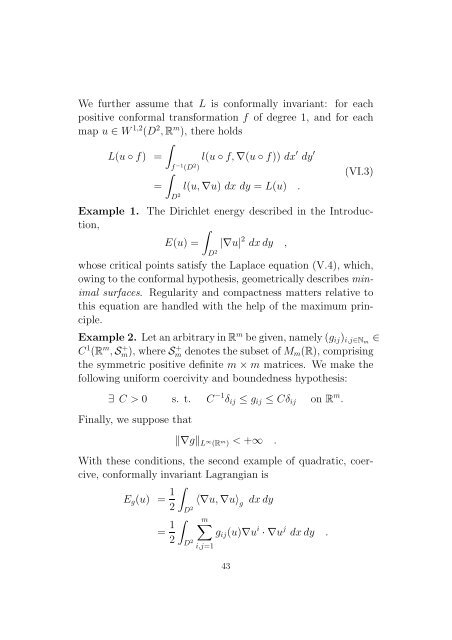Conformally Invariant Variational Problems. - SAM
Conformally Invariant Variational Problems. - SAM
Conformally Invariant Variational Problems. - SAM
Create successful ePaper yourself
Turn your PDF publications into a flip-book with our unique Google optimized e-Paper software.
We further assume that L is conformally invariant: for each<br />
positive conformal transformation f of degree 1, and for each<br />
map u ∈ W 1,2 (D 2 ,R m ), there holds<br />
∫<br />
L(u◦f) = l(u◦f,∇(u◦f)) dx ′ dy ′<br />
f −1 (D 2 )<br />
∫<br />
(VI.3)<br />
= l(u,∇u) dx dy = L(u) .<br />
D 2<br />
Example 1. The Dirichlet energy described in the Introduction,<br />
∫<br />
E(u) = |∇u| 2 dxdy ,<br />
D 2<br />
whose critical points satisfy the Laplace equation (V.4), which,<br />
owing to the conformalhypothesis, geometricallydescribes minimal<br />
surfaces. Regularity and compactness matters relative to<br />
this equation are handled with the help of the maximum principle.<br />
Example 2. LetanarbitraryinR m begiven,namely(g ij ) i,j∈Nm ∈<br />
C 1 (R m ,S + m), whereS + m denotesthe subset of M m (R), comprising<br />
the symmetric positive definite m×m matrices. We make the<br />
following uniform coercivity and boundedness hypothesis:<br />
∃ C > 0 s. t. C −1 δ ij ≤ g ij ≤ Cδ ij on R m .<br />
Finally, we suppose that<br />
‖∇g‖ L∞ (R m ) < +∞ .<br />
With these conditions, the second example of quadratic, coercive,<br />
conformally invariant Lagrangian is<br />
E g (u) = 1 ∫<br />
〈∇u,∇u〉<br />
2 g<br />
dxdy<br />
D 2<br />
= 1 ∫<br />
∑ m<br />
g ij (u)∇u i·∇u j dxdy .<br />
2<br />
D 2<br />
i,j=1<br />
43
















